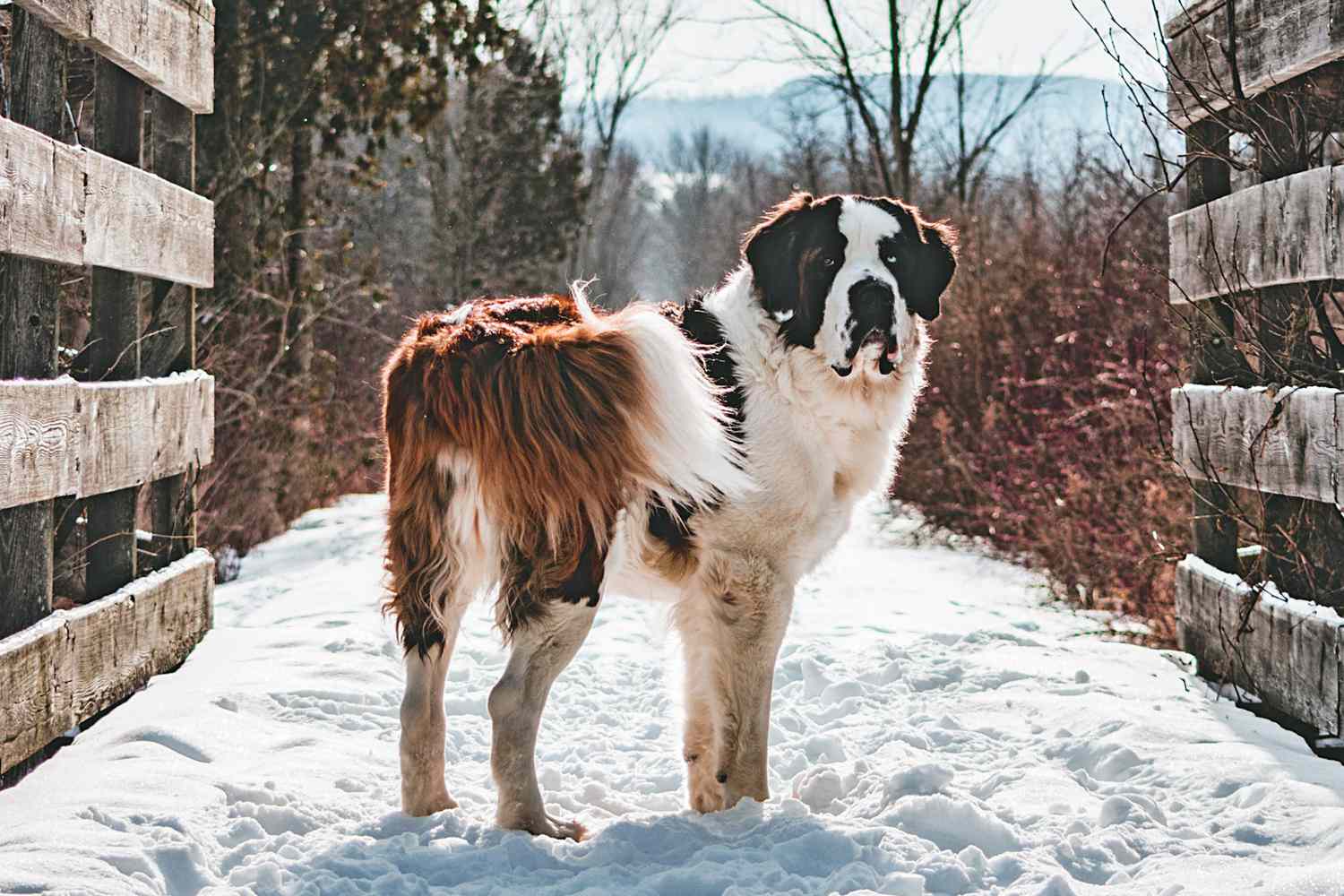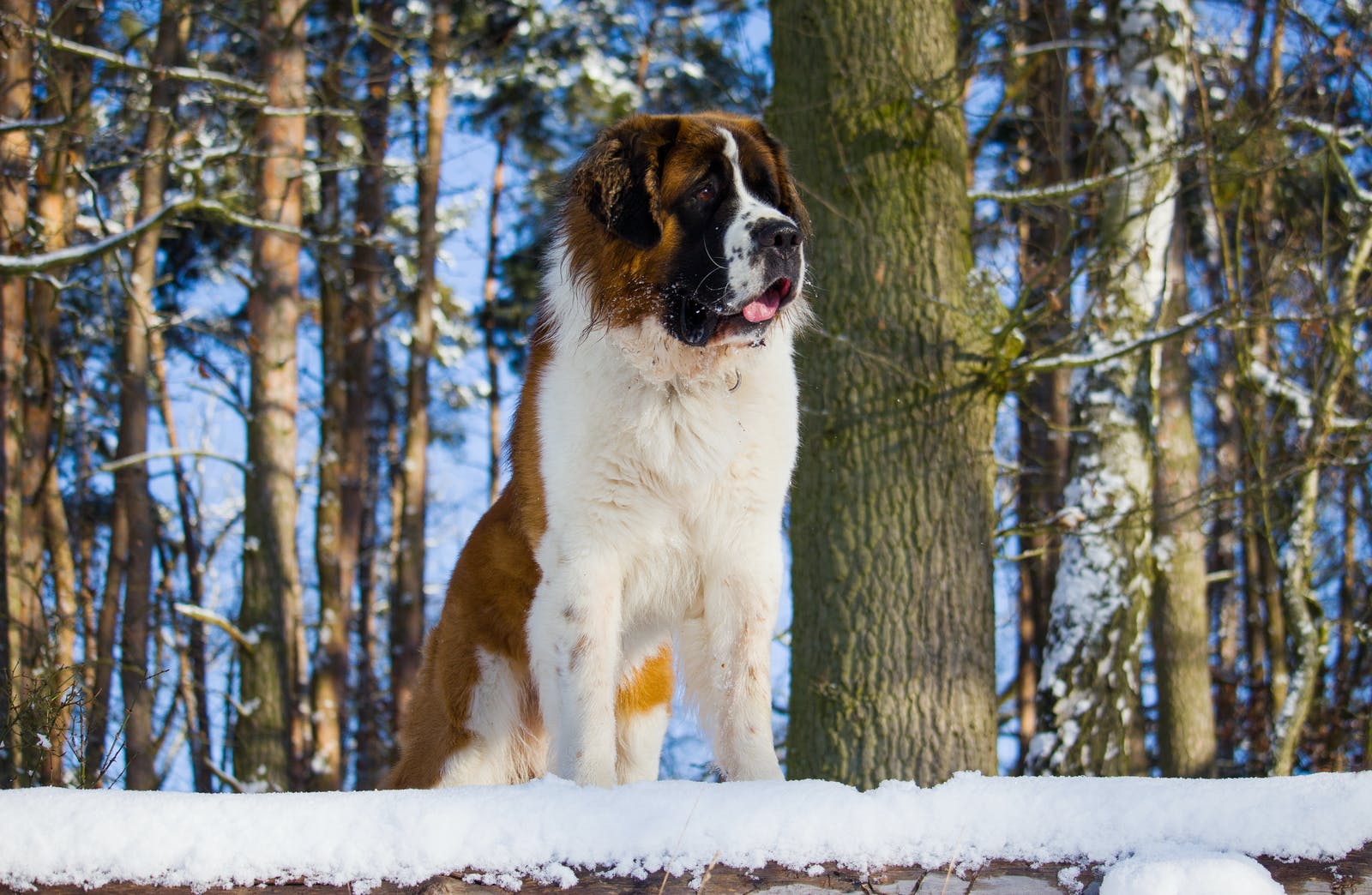The Saint Bernard is a breed of very large working dog from the western Alps in Italy and Switzerland. They were originally bred for rescue work by the hospice of the Great St Bernard Pass on the Italian-Swiss border. The hospice, built by and named after Italian monk Bernard of Menthon, acquired its first dogs between 1660 and 1670. They are known for their enormous size, friendly temperament, and their legends of rescue. Today, Saint Bernards are beloved family companions and pets all over the world.
Overview of the Saint Bernard Breed

Saint Bernards are giant, very muscular dogs with a broad, big head and a friendly yet dignified expression. They have drooping upper lips and very large paws with webbed feet. Their fur is dense and comes in a variety of colors like redish-brown brindle, redish-brown splash coats, redish-brown mantle. They also have distinctive white markings on the chest, toes, nose, and tip of tail.
The average height of a male St. Bernard is 70 to 90 cm (27.5 to 35 in) at the withers. Females are usually a little smaller at 65 to 80 cm (25.5 to 31 in). They generally weigh between 60 to 120 kg (130 to 260 lb).
Originally bred to rescue people trapped in snowstorms in the Alps, St. Bernards have legendary big-heartedness and keen sense of direction even in poor visibility. They have highly developed sense of hearing and smell which helped them find lost travellers.
They are generally friendly, calm, patient and eager to please. They are excellent pets and companions for people of all ages and get along very well with kids if properly socialized from a young age. They do require regular moderate exercise daily. Overall an affectionate gentle giant that thrives when close to people.
Some drawbacks of the breed – they drool a lot and are prone to flatulence. They also shed heavily twice a year. They require frequent brushing and can be a chore to keep the house clean. Saint Bernards also typically have short life spans of 8 to 10 years.
Pros of Owning a Saint Bernard

- Good with kids – Due to their patience and easy-going nature, St. Bernards are great family pets and wonderful companions for children if properly trained. Their large size also makes them very huggable!
- Low exercise needs – As a giant breed meant for strength not speed, 45 to 60 minutes of exercise daily is enough for a St. Bernard to stay fit.
- Intelligent and eager to please – Saint Bernards are moderately easy to train and housebreak if consistent positive techniques are used.
- Minimal barkers – They are usually quiet dogs who only bark if extremely provoked or needing something. Less nuisance barking makes them good pets for apartments or condos.
- Cold weather tolerant – With their thick double coat and large size generating body heat, Saint Bernards can enjoy cold weather better than most breeds and make great pets for people living in cold climates.
Cons of Owning a Saint Bernard

- Expensive to feed – Their massive size means St. Bernards eat a lot. Feeding costs for even mid-quality kibble can be $100 to $150 per month.
- Vet expenses higher than average – As giant breed dogs with higher than average health issues, vet costs tend to pile up, especially in later years.
- Slobber and drool frequently – Excessive drooling is part of the breed. Saint Bernards slobber after eating and drinking and fling saliva around when shaking their heads.
- Shed heavily – The double-coat sheds heavily during seasonal changes. Lots of vacuuming is needed to control shed hair and dander inside home.
- Prone to several health issues – Elbow hip dysplasia, eye conditions, cardiovascular problems are some common health issues seen in the breed.
Shorter lifespan – An average St. Bernard lives 8 to 10 years due to their rapid growth and giant size predisposing them to bone/joint problems and heart conditions.
Advice on Owning a Saint Bernard

Selecting a Healthy Saint Bernard Puppy
- Ask breeders about medical history of puppy’s parents and grandparents specifically checking for heart, bone, joint and eye health. Responsible breeders will routinely test breeding dogs for breed-related conditions.
- See OFA / PennHIP certification for hip joints, OFA elbow certification for elbow joints from breeder.
- Meet at least the puppy’s mother in person to gauge temperament energy levels.
- Select friendly, lively puppies from clean facilities. Avoid fearful, aggressive or inactive puppies.
Caring for a Saint Bernard
- Nutrition – Feed high-quality commercial dog food formulated for large breeds. Limit rapid weight gain growth to improve joint health. Don’t overfeed treats.
- Grooming – Brush coat twice weekly to control shedding. Trim overgrown fur between paw pads if unable to exercise on hard surfaces. Clean facial folds wrinkles regularly.
- Exercise – Daily moderate exercise totalling 45 to 60 minutes – leash walks, play sessions in fenced area. Avoid high impact activities that put force on joints.
- Training – Start training early on. Use positive reinforcement techniques. Housetraining may take longer due to large size. Crate training recommended. Teach commands to stop jumping due to size.
- Health – Get vet checks twice a year. Stay aware of signs of common health issues like bloat, bone/joint problems, eye heart conditions etc. Better to get medical intervention sooner than later.
Is a Saint Bernard Right for You?
Things to consider before getting a St. Bernard –
- They are giant dogs weighing 100-180 pounds – Consider size constraints of your home. Prepare for expenses related to food, medications, supplies suited to giant breeds.
- They have high grooming needs – Brushing couple times a week is a must to control shedding. Be prepared to vacuum often.
- Saint Bernards shed a lot year round – If anyone in your home has allergies or asthma, this may not be an ideal breed.
- They drool, slobber excessively – If you dislike or can’t deal with copious amounts of drool and slobber in your home, reconsider your choice.
- Saint Bernards prefer living indoors with their human families. They do not do well isolated in backyard or kennels. Only get this breed if you intend for it to spend majority of time with family indoors.
Conclusion
In conclusion, Saint Bernards are impressively large yet gentle and noble dogs with moderately high care requirements and higher than average health problems. But to an experienced dog owner able to provide for their considerable needs in food, grooming, training, healthcare and home space, they can make wonderfully endearing and enjoyable companion pets. Their sweet, loyal personality combined with stunning size and looks makes them one of the most popular giant dog breeds for families wanting a big gentle pet!